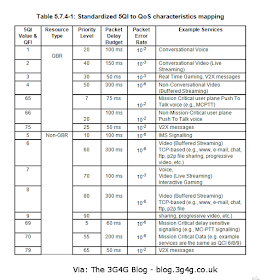NSA is based on Option 3 (proposed by DT). If you dont know much about this, then I suggest listening to Andy Sutton's lecture here.
3GPP TR 38.804: Technical Specification Group Radio Access Network; Study on New Radio Access Technology; Radio Interface Protocol Aspects provides the overall architecture as shown above
Compared to LTE the big differences are:
- Core network control plane split into AMF and SMF nodes (Access and Session Management Functions). A given device is assigned a single AMF to handle mobility and AAA roles but can then have multiple SMF each dedicated to a given network slice
- Core network user plane handled by single node UPF (User Plane Function) with support for multiple UPF serving the same device and hence we avoid need for a common SGW used in LTE. UPF nodes may be daisy chained to offer local breakout and may have parallel nodes serving the same APN to assist seamless mobility.
Hat tip Alistair Urie.
Notice that like eNodeB (eNB) in case of LTE, the new radio access network is called gNodeB (gNB). Martin Sauter points out in his excellent blog that 'g' stands for next generation.3GPP TS 23.501: Technical Specification Group Services and System Aspects; System Architecture for the 5G System; Stage 2 provides architecture model and concepts including roaming and non-roaming architecture. I will probably have to revisit as its got so much information. The QoS table is shown above. You will notice the terms QFI (QoS Flow Identity) & 5QI (5G QoS Indicator). I have a feeling that there will be a lot of new additions, especially due to URLLC.
Finally, here are the specifications (hat tip Eiko Seidel for his excellent Linkedin posts - references below):
5G NR will use 38 series (like 25 series for 3G & 36 series for 4G).
RAN3 TR 38.801 v2.0.0 on Study on New Radio Access Technology; Radio Access Architecture and Interfaces
RAN1 TR 38.802 v2.0.0 on Study on New Radio (NR) Access Technology; Physical Layer Aspects
RAN4 TR 38.803 v2.0.0 on Study on New Radio Access Technology: RF and co-existence aspects
RAN2 TR 38.804 v1.0.0 on Study on New Radio Access Technology; Radio Interface Protocol Aspects
38.201 TS Physical layer; General description
38.211 TS Physical channels and modulation
38.212 TS Multiplexing and channel coding
38.213 TS Physical layer procedures
38.214 TS Physical layer measurements
38.21X TS Physical layer services provided to upper layer
38.300 TS Overall description; Stage-2
38.304 TS User Equipment (UE) procedures in idle mode
38.306 TS User Equipment (UE) radio access capabilities
38.321 TS Medium Access Control (MAC) protocol specification
38.322 TS Radio Link Control (RLC) protocol specification
38.323 TS Packet Data Convergence Protocol (PDCP) specification
38.331 TS Radio Resource Control (RRC); Protocol specification
37.3XX TS [TBD for new QoS]
37.3XX TS Multi-Connectivity; Overall description; Stage-2
38.401 TS Architecture description
38.410 TS NG general aspects and principles
38.411 TS NG layer 1
38.412 TS NG signalling transport
38.413 TS NG Application Protocol (NGAP)
38.414 TS NG data transport
38.420 TS Xn general aspects and principles
38.421 TS Xn layer 1
38.422 TS Xn signalling transport
38.423 TS Xn Application Protocol (XnAP)
38.424 TS Xn data transport
38.425 TS Xn interface user plane protocol
38.101 TS User Equipment (UE) radio transmission and reception
38.133 TS Requirements for support of radio resource management
38.104 TS Base Station (BS) radio transmission and reception
38.307 TS Requirements on User Equipments (UEs) supporting a release-independent frequency band
38.113 TS Base Station (BS) and repeater ElectroMagnetic Compatibility (EMC)
38.124 TS Electromagnetic compatibility (EMC) requirements for mobile terminals and ancillary equipment
38.101 TS User Equipment (UE) radio transmission and reception
38.133 TS Requirements for support of radio resource management
38.104 TS Base Station (BS) radio transmission and reception
38.141 TS Base Station (BS) conformance testing
Note that all specifications are not in place yet. Use this link to navigate 3GPP specs: http://www.3gpp.org/ftp/Specs/archive/38_series/
Further reading:
- 3GPP 5G Specifications - Jan 2018 update
- Qualcomm: 3GPP agrees on plan to accelerate 5G NR – the global 5G standard – for 2019 deployments
- 3GPP 5G Study completed by RAN --- Let's look at the Technical Reports
- Structure of the 3GPP NR (5G) Specification












